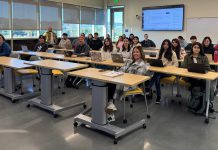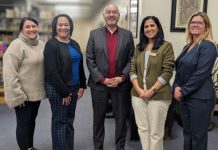Class of 2006 will be the first required to pass the Exit Exam;
Implementation of Exit Now! expected to help prepare students
Gilroy – As seniors across the district returned to school this year, some are carrying an additional weight on their shoulders – and it’s not their backpack. The Class of 2006 is the first in the state required to pass the California High School Exit Exam in order to receive their diploma – and dozens of seniors at Mt. Madonna Continuation High School have yet to clear the hurdle.
The Gilroy Unified School District board unanimously approved a $55,750 contract Thursday with the Extreme Learning Center to implement Exit Now!, a CAHSEE preparation course used to help more students pass the test.
“Let’s face it, our students have to pass the CAHSEE. If you have a plan that increases their chances of passing, (the board members) are going to support it,” said Assistant Superintendent of Administrative Services Steve Brinkman.
Exit Now! was first used in summer school programs in the district two years ago, and students who have taken the course have made significant improvements based upon studies provided by the Princeton Review.
About $30,000 in funding is from a program Gov. Arnold Schwarzenegger is promoting, which provides districts with $600 per student for CAHSEE preparation courses. The rest of the cost should be covered by money available in GUSD’s Cal-Safe program. The money will be used to pay for seven additional computers and academic coaches teaching the class.
According to Brinkman, new Mt. Madonna Principal Sergio Montenegro asked for the program to continue this school year since a number of seniors still need to pass either the English Language Arts or math sections of the exit exam.
Fifty students at Mt. Madonna are enrolled in the course. Half attend class for one hour everyday – they still need to pass both sections. The others who have to pass one section are enrolled in the afterschool course and come twice a week.
Students are given an assessment test to determine areas of they need to improve and are provided with their own computer and workbooks. Their progress is tracked in biweekly reports by their Extreme Learning coach or classroom teacher.
“Everything that they’re doing is covered on the test,” said Steven Solorio, Mt. Madonna’s learning coach.
About 80 percent of the students in Solorio’s class are seniors. They practice writing essays, as well as target basic reading and mathematical skills.
He believes it will take a combination of factors to get seniors to pass, including support from administrative staff, their academic coaches and parents to push them over the bar.
“I think it can’t be up to one person,” he said.
Seniors at Mt. Madonna aren’t the only students with an additional support system this year.
“We actually have classes that (students) are required to be in, either for English Language Arts or math or both if they have not passed the high school exit exam,” said Gilroy High School Principal James Maxwell. “We are waiting imminently for the governor to release some money … which literally could be any day.”
Once the district receives more funding, all students enrolled in CAHSEE prep courses will be required to attend Saturday classes.
“We don’t want any kid to say we didn’t give them any help,” Maxwell said.
GHS administrators are still determining the number of students who need to pass the CAHSEE. As of last year, about 80 students still needed to pass – 30 of whom were special education students.
However, the figure fluctuates due to students moving in and out of Gilroy and transfers from private schools not required to take the exam.
The number of GHS students who need to pass this year may fluctuate dramatically if the governor signs legislation excusing certain special education students from having to pass the CAHSEE.
“We definitely have special education students who have not passed,” Maxwell said. “We are really sitting on the edge – what should we do? Make a decision,” he sighed about the legislation.
According to GHS Assistant Principal Kat Hannah, about 180 special education students attend GHS. Resource Specialist students (RSP) make up the majority of Special Ed students – about 100 to 110 – the rest are considered Special Day students.
Some RSP students require assistance from speech therapists once a week, others have learning disabilities such as dyslexia. Most RSP students’ classes are general education and they receive at least one or a combination of services from the Special Education department depending upon their needs. These students are on the graduation tract and expected to pass the CAHSEE.
Special Day Students require intensive special education classes and are not on the graduation tract. They attend school under agreement by their parents that they will not receive a traditional high school diploma and are not expected to take the exit exam.
Despite the pending legislation, “We’re still providing as intensive courses as we would anyone else who has to pass the CAHSEE,” Hannah explained. “For RSP students it is expected that they are to graduate and pass the CAHSEE.”














